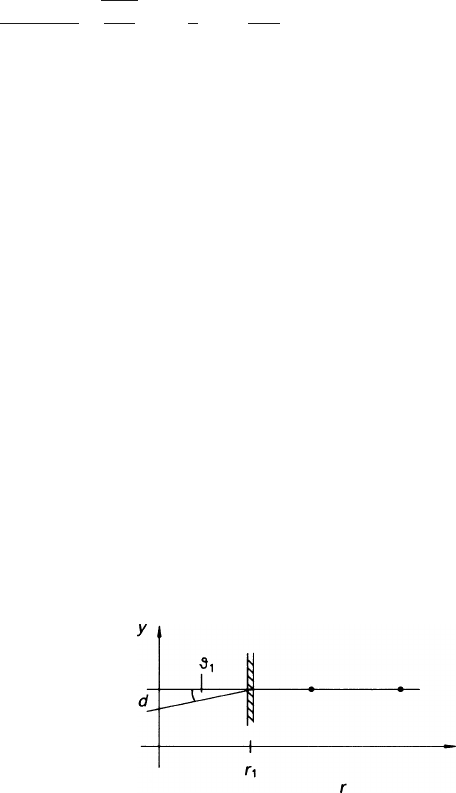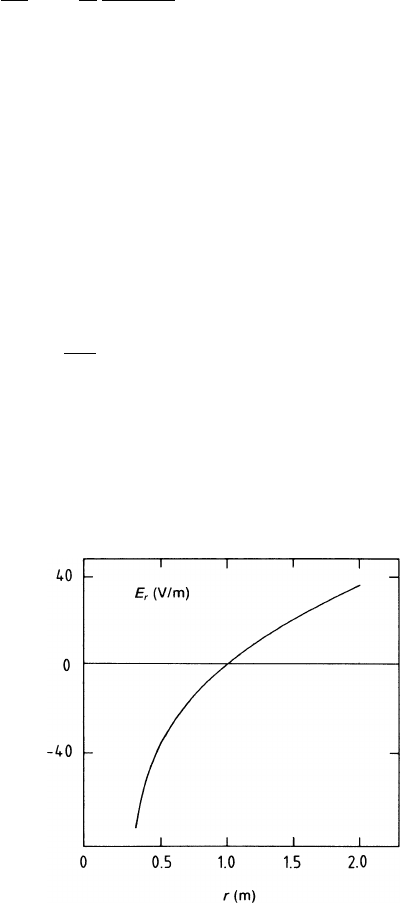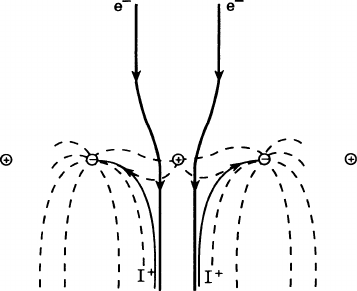Blum W., Riegler W., Rolandi L. Particle Detection with Drift Chambers
Подождите немного. Документ загружается.


8.4 Limitations Due to Multiple Scattering 309
sum of the large majority of events, which are dominated by small-angle scattering
alone. This behaviour is typical for Coulomb scattering as described by the Ruther-
ford formula; for hadrons, nuclear elastic scattering also makes a contribution to the
tail. All the theories that go beyond the simple approximation discussed above are
analytically quite complex.
Highland [HIG 75] has taken a practical standpoint by fitting the width of the
scattering-angle distribution of the Moliere theory to a form similar to (8.53), using
the radiation lengths as listed in the Particle Data Tables (and partly in our Table 8.6).
He finds that the width of Moliere does not vary appreciably with the nuclear
charge number Z; he introduces an x-dependent correction factor (1 +
ε
(x))to
(8.53), which redefines the energy constant. His result is
θ
1/e
y
=
14.1MeV
β
cp
x
X
rad
1+
1
9
log
10
x
X
rad
. (8.55)
θ
1/e
y
is the angle in the x–y plane at which the Moliere probability density is down
by a factor of 1/e from the maximum. Formula (8.55) is supposed to be accurate to
5% in the range 10
−3
< x/X
rad
< 10, except for the very light elements, where the
accuracy is 10–20%.
8.4.2 Vertex Determination
At colliders the observation of primary vertices and of secondary vertices from par-
ticles with short lifetimes is through a vacuum tube; in addition there is the material
of the vertex chamber itself. We would like to compute the vertex localization error
due to multiple scattering in these materials. The situation is sketched in Fig. 8.6.
We assume for simplicity that the track is infinitely well measured outside the scat-
tering material. Upon extrapolation, it misses the vertex position by the distance d.
The average over the square of d is equal to
d
2
=
ϑ
2
1
r
2
1
+
ϑ
2
2
r
2
2
+ ··· , (8.56)
where the mean squared projected scattering angle
ϑ
2
1
is given by the thickness t
i
of the layer i in units of radiation lengths of the material i according to (8.53), where
ϑ
2
=
θ
2
y
. We express the r.m.s. value of d in terms of a ‘Coulomb scattering
Fig. 8.6 Coulomb multiple
scattering of an infinitely well
measured track

310 8 Geometrical Track Parameters and Their Errors
limit’ S
c
of the vertex localization accuracy. By combining (8.56) and (8.53) we
have
"
d
2
=
S
c
β
pc
, (8.57)
with
S
c
= 15MeV
+
∑
t
i
r
2
i
,
1/2
. (8.58)
Practical values of S
c
range between 45 and 200μm GeV for various experiments;
compare Table 11.3.
The above calculation gives correct vertex errors in the limit that the Coulomb
scattering is much larger than the measurement errors and that all the scattering ma-
terial is between the sense wires and the vertex. For the general case the estimation
of vertex errors is more involved. Although the quadratic addition of measure-
ment errors (8.7) and the multiple-scattering errors (8.57) gives the right order of
magnitude for the total, more sophisticated estimation methods give better results.
Lutz [LUT 88] has developed an optimal tracking procedure by fitting the individual
contributions to multiple scattering between the measuring points.
8.4.3 Resolution of Curvature for Tracks Through
a Scattering Medium
We have seen in (8.53) that the mean square scattering angle increases as the
momentum of the particle becomes smaller. Let us imagine a drift chamber in a
spectrometer where the momentum of a particle is low enough to make the multiple-
scattering error the dominating one. We would like to know the accuracy for a
measurement of the curvature in this situation; this implies we suppose that the ac-
curacy of the apparatus itself is infinitely better than the multiple-scattering errors.
We resume the arguments of Sect. 8.2 at (8.2.1). In order to evaluate [y
n
y
m
] in the
case of multiple scattering, we observe that
[y
n
y
m
]=[y
n
(y
n
+(x
m
−x
n
)
θ
yn
]=[y
2
n
]+(x
m
−x
n
)[y
n
θ
yn
] (8.59)
for x
m
≥ x
n
. Now we make use of (8.49) and (8.50) and obtain
[y
n
y
m
]=
Θ
2
s
x
2
n
(3x
m
−x
n
)/12 . (8.60)
Gluckstern [GLU 63] has evaluated the correlation coefficients at the first of
N + 1 uniformly spaced wires with the result
[c
2
]
MS
=
Θ
2
s
2L
C
N
,
cb
1
2
MS
= −
Θ
2
s
2
D
N
, (8.61)

8.5 Spectrometer Resolution 311
Table 8.7 Values of the factors C
N
,D
N
and E
N
in (8.61) for various values of N
NC
N
D
N
E
N
2 1.33 0.167 0.167
3 1.25 0.125 0.154
4 1.25 0.124 0.160
5 1.26 0.132 0.167
9 1.31 0.156 0.187
infin. 1.43 0.214 0.229
b
2
1
2
MS
=
Θ
2
s
2
LE
N
.
The N-dependent coefficients are listed in Table 8.7.
Let us note that the measurement accuracy
√
[c
2
] for the curvature in this
multiple-scattering-limited case is inversely proportional to the square-root of the
length. Also, the variations of b and c are much more independent than they were in
the measurement-limited case (8.32), because the ratio D
N
/
√
(C
N
E
N
) is relatively
small.
The problem of optimal spacing and optimal weighting has been treated by
Gluckstern [GLU 63] as well as by some other authors cited in his paper.
8.5 Spectrometer Resolution
Much of the effort of constructing precise drift chambers was for the goal of high-
resolution magnetic spectrometers. In this section we want to collect our results
concerning the measurement errors of curvature and to express them in terms of
momentum resolution. We are concerned with measurements inside a homogeneous
magnetic field. There were two limiting cases, the one caused by measurement er-
rors, in the absence of multiple scattering, and the other due to multiple scattering,
with zero measurement errors.
8.5.1 Limit of Measurement Errors
We noted before that the variance [c
2
] of the curvature is a function of the track
length L, the point-measuring accuracy
ε
, and the number N + 1 of wires, but it
does not depend on the curvature itself. For uniform wire spacing we had (8.24)
[c
2
]=
ε
2
L
4
A
N
(A
N
in Table 8.2)
and for wires with optimum spacing (8.34)
[c
2
]=
ε
2
L
4
256
N + 1
.

312 8 Geometrical Track Parameters and Their Errors
The track length is understood to be measured in a plane orthogonal to the magnetic
field.
In order to calculate the momentum resolution, we use (8.9) and (8.11) and ex-
press the r.m.s. error
δ
(1/R)=
√
[c
2
] as
"
[c
2
]=
δ
1
R
= eB
δ
1
p
T
= −eB
δ
p
T
p
2
T
=
−3
10
GeV/c
Tm
B
δ
p
T
p
2
T
. (8.65)
Introducing
θ
, the angle between the momentum vector and the magnetic field, the
transverse component p
T
is given by
p
T
= psin
θ
. (8.66)
We drop the minus sign and write (8.65) as
δ
p
p
= psin
θ
10
3
Tm
GeV/c
1
B
"
[c
2
] . (8.67)
This formula shows that the spectrometer resolving power, expressed as a percent-
age of the measured momentum, deteriorates proportionally to p. This follows from
the fact that [c
2
] is independent of c; it is also visible directly in the sagitta s
(Sect. 8.2.3), whose size can be measured with less relative accuracy
δ
s/s as it
shrinks with increasing momentum.
8.5.2 Limit of Multiple Scattering
In this case the variance [c
2
] depends on the track length L, the mean square scatter-
ing angle per unit length,
Θ
2
s
, and very weakly on the number of measuring points.
Θ
2
s
in turn is a function of the scattering material and of the
β
p of the particle. Using
(8.51) and (8.61) we had for uniform wire spacing
[c
2
]
MS
=
21MeV
β
cp
2
1
X
rad
C
N
2L
(C
N
in Table8.7) . (8.68)
L is the length the track has travelled in the medium and [c
2
] the variance of
the total curvature. Only a projection on a plane perpendicular to the magnetic
field can be confused with a curvature variation caused by a variation in
momentum,
[c
2
proj
]=[c
2
]
MS
/sin
4
θ
, (8.69)
because the projected radius of curvature scales with the square of the projected
length. It is [c
2
proj
]
MS
to which (8.67) applies in the present case, and we find for the
momentum resolution

References 313
δ
p
p
=
p
sin
θ
10
3
Tm
GeV/c
1
B
"
[c
2
]
MS
.
=
21(MeV/c)
β
sin
θ
10
3
Tm
GeV/c
1
B
C
N
2LX
rad
.
(8.70)
We see that the multiple-scattering limit of the momentum resolution is inde-
pendent of momentum because, as p goes up, the decrease in bending power is
compensated by the decrease in the scattering angle. According to (8.70), a muon
traversing 1 m of magnetized iron (2T) at right angles to the field cannot be mea-
sured better than to 22%, even if there were infinitely many measuring points with
infinite accuracy inside the iron. Depending on the apparatus, L will often be a func-
tion of the angle
θ
.
References
[BET 53] H.A. Bethe, Moliere’s theory of multiple scattering, Phys. Rev. 89, 1256 (1953)
[BOC 90] R.K. B
¨
ock, H. Grote, D. Notz, M. Regler, Data analysis techniques for high-energy
physics experiments (Cambridge University Press, Cambridge, UK 1990)
[GLU 63] R.L. Gluckstern, Uncertainties in track momentum and direction due to multiple scat-
tering and measurement errors, Nucl. Instr. Meth. 24, 381 (1963)
[HIG 75] V.L. Highland, Some practical remarks on multiple scattering, Nucl. Instrum. Meth-
ods 129, 497 (1975)
[LUT 88] G. Lutz, Optimum track fitting in the presence of multiple scattering, Nucl. Instrum.
Methods Phys. Res. A 273, 349 (1988)
[MOL 48] G. Moliere, Theorie der Streuung schneller geladener Teilchen II, Mehrfach und
Vielfachstreuung, Z. Naturforsch. 3a, 78 (1948)
[PAR 04] Particle Data Group, Review of Particle Properties, Phys. Lett. B 592 (2004)
[ROS 52] B. Rossi, High-Energy Particles (Prentice-Hall, Englewood Cliffs, NJ, USA 1952)
[SCO 63] W.T. Scott, The theory of small-angle multiple scattering of fast charged particles,
Rev. Mod. Phys. 35, 231 (1963)
[SEL 72] S.M. Selby (ed.), Standard Mathematical Tables (The Chemical Rubber Co.,
Cleveland, Ohio, USA 1972)
[TSA 74] Y.-S. Tsai, Pair production and bremsstrahlung of charged leptons, Rev. Mod. Phys.
46, 815 (1974)

Chapter 9
Ion Gates
Here we wish to take up the subject of ion shutters, which are sometimes placed
in the drift space in order to block the passage of electrons or ions. In Chap. 3 we
introduced such wire grids in the context of the electrostatics of drift chambers,
stressing the relation between the various grids and electrodes that make up a drift
chamber. So far we have dealt with the most straightforward type of gating grid,
where all the wires are at the same potential.
For applications in large drift chambers there are more sophisticated forms of ion
shutters which, in some modes of operation, have different transmission properties
for electrons and for heavy ions.
We will begin this chapter by inspecting the conditions that make it necessary to
involve gating grids (Sect. 9.1). Then we will survey various forms of gating grids
that are in use in particle experiments (Sect. 9.2). Finally we compute values for
the transparency under various conditions for which we make use of the results of
Chap. 2 concerning ion drift velocities and the magnetic drift properties of electrons
in gases.
9.1 Reasons for the Use of Ion Gates
9.1.1 Electric Charge in the Drift Region
Any free charges in the drift volume give rise to electric fields which superim-
pose themselves on the drift field and distort it. Chambers with long drift lengths
L are particularly delicate, especially when they are operated with a low drift field.
The displacement
σ
x
of an electron drift path at its arrival point is of the order
of the drift length times the ratio of the disturbing field E
dist
over the drift field
E
drift
:
σ
x
= L
E
dist
E
drift
. (9.1)
W. Blum et al., Particle Detection with Drift Chambers, 315
doi: 10.1007/978-3-540-76684-1
9,
c
Springer-Verlag Berlin Heidelberg 2008

316 9IonGates
This holds if the disturbing field is orthogonal to the drift field, thus causing a
displacement of the field lines to the side, but it also holds if the disturbing field
acts in the same direction as the drift field, thus causing a change in the velocity and
hence of the arrival time, provided the chamber works in the unsaturated mode of
the drift velocity (cf. Chap. 12).
Free charges can originate as electrons or gas ions from the ionization in the
drift volume, travelling in opposite directions according to their proper drift veloc-
ities, or they can be ions from the wire avalanches that have found their way into
the drift region, where they move towards the negative high-voltage electrode. This
last category contributes the largest part because for every incoming electron which
causes G avalanche ions to be produced at the proportional wire, there will be G
ε
in the drift space, where
ε
is the fraction that arrives in the drift space rather than
on the cathodes opposite the proportional wire. If there is no gating grid, G
ε
will
be of the order of 10
3
in typical conditions, but could also be larger (see remarks
below).
In order to estimate the size of disturbing fields we consider two examples. The
first is a drift chamber in which a gas discharge burns continuously between some
sense wires and their cathodes. Such a self-sustained process could be caused by
some surface deposit on the cathode, or otherwise. Let the total current be 1μA, and
let
ε
= 5% of it penetrate into the drift volume. If the ion drift velocity there is 2 m/s,
then the linear charge density in the column of travelling ions is
λ
= 25 ×10
−9
A
s/m. Using Gauss’ theorem in this cylindrical geometry, the resulting radial field a
distance r away amounts to
E
dist
=
λ
2
π
r
ε
0
= 450(V)
1
r
. (9.2)
Here we have neglected the presence of any conductors.
The second example is the ALEPH TPC, irradiated by some ionizing radiation,
say cosmic rays or background radiation from the e
+
e
−
collider. Let the rate density
of electrons liberated in the sensitive volume be R(s
−1
m
−3
). For every electron, G
ε
ions will appear in the drift space, where they travel with velocity v
D
. Therefore the
total charge density in the volume has the value.
ρ
=
eRLG
ε
v
D
, (9.3)
where e is the charge of the electron and L is the length of the drift volume.
ρ
could
depend on the radius r, as one would expect from radiation originating along the
beam. Let the TPC be approximated by the space between two infinite coaxial con-
ducting cylinders with radii r
1
= 0.3 m and r
2
= 2 m, with the drift direction parallel
to the common axis. The cylinders are grounded. The radial field E
r
is calculated
from Maxwell’s equations,
∇E
r
=
1
r
∂
∂
r
rE
r
=
ρ
ε
0
, (9.4)

9.1 Reasons for the Use of Ion Gates 317
r
2
r
1
E
r
dr = 0 .
If
ρ
(r)=
ρ
0
does not depend on r, as in the case of irradiation by cosmic rays, the
resulting radial disturbing field takes the form
E
r
(r)=
ρ
0
2
ε
0
r −
1
2r
r
2
2
−r
2
1
ln(r
2
/r
1
)
. (9.5)
If we insert into (9.3) values that are characteristic for the ALEPH TPC irradiated
by cosmic rays at sea level (R = 2×10
6
s
−1
m
−3
, v
D
= 1.5m/s,G
ε
= 10
3
,L = 2m),
we find that
ρ
0
= 0.43×10
−9
Asm
−3
. Figure 9.1 shows the radial field that results
from (9.5) in this particular example. We notice that it is negative close to the inner
field cage and positive close to the outer one. Compared to the regular axial drift
field of 10
4
V/m, it amounts to a fraction of a per cent.
It should be mentioned that the coefficient
ε
is not very well known. A lower limit
can be evaluated assuming that the amplification produced ions uniformly around
the proportional wire. In this case
ε
is equal to the fraction of electric field lines that
reach from the sense wire into the drift region. Using the formalism of Sect. 3.2
ε
is equal to the ratio of the surface charge densities on the high-voltage plane and on
the sense wire grid:
ε
=
|
σ
p
|
σ
s
, (9.6)
typically between 3 and 5%.
However, it is known that the amplification is not isotropic around the propor-
tional wire. This has been discussed in Sect. 4.3. Large avalanches tend to go around
the wire; small avalanches develop on the side where the electrons have arrived. The
ions from the small avalanches may go into the drift space more efficiently. Nothing
quantitative has been published concerning this question.
Fig. 9.1 Radial dependence
of the electric field produced
by a uniform charge
distribution in a cylindrical
TPC. The scales are from the
example discussed in the text
318 9IonGates
Some further uncertainty exists concerning the value of v
D
. The effect of charge
transfer between the travelling ions and any gas molecules of low ionization poten-
tial will substitute these molecules, which are often much slower, for the original
ions; see Table 2.2. This effect creates a space charge that is not uniform in the drift
direction.
The most important contribution to space charge is usually created by the back-
ground radiation at the accelerator. Background conditions can be very different
from one experiment to the other. In the ALEPH TPC at LEP (sensitive volume
45m
3
) the sense-wire current is ∼ 0.5μA under standard operating conditions. The
UA1 central detector at the CERN Sp
¯
pS (sensitive volume 25m
3
) had a current of
∼ 120μA at the peak luminosity of 3 ×10
29
cm
−2
s
−1
[BEI 88].
9.1.2 Ageing
There is experimental evidence of a deterioration in performance of drift and pro-
portional chambers after they have been used for some time. Once the total charge
collected on the anode wires during their lifetime exceeds some value between 10
−4
and 1 C per cm of wire length, a loss of gain and excessive dark currents are observed
in many chambers. Whereas a short account of this problem is given in Sect. 12.6,
we mention it in the context of ion gates in order to underline their effect on the
ageing process.
The dose mentioned above is the product of the incoming charge and the gain
factor. The limit of observable deteriorations depend very much on the gas com-
position and on the electric field on the electrode surfaces; under carefully chosen
conditions, a limiting dose of the order of 0.1 to 1 C/cm should be achievable. Some
modern experiments even expect to achieve 10 C/cm (cf. Sect. 12.6). The ageing
process can be stretched in time if only part of the radiation is admitted to the sense
wires, using a gate that is triggered only on interesting events.
9.2 Survey of Field Configurations and Trigger Modes
In order to describe the various forms of gating grids employed in particle ex-
periments we use two classifications, one according to drift paths on the basis of
different (electric and magnetic) field configurations, the other according to the dy-
namical behaviour, i.e. how the gates are switched in connection with events in time.
9.2.1 Three Field Configurations
The simplest gate is the one which has all its wires at the same potential (monopolar
gating grid). We have stated in Sect. 3.3 that it is closed to incoming electrons and
outgoing ions if all the field lines terminate on it, provided the common potential is
large enough and positive (Fig. 3.10b).

9.2 Survey of Field Configurations and Trigger Modes 319
There is a technical difficulty connected with this configuration: any transition
from the closed to the open state must occur in a time interval
Δ
T comparable to
the electron travel time over a distance small compared to the sensitive drift length,
say
Δ
T ≈ 1μs or less. The charge brought onto the grid in this short time causes an
enormous disturbance on the nearby sense wires, orders of magnitudes larger than a
signal. One solution to this problem is the introduction of a ‘shielding grid’ between
the gating grid and the anode [BRY 85].
Another way to circumvent this difficulty is to close the gating grid by
ramping two opposite potentials +
Δ
V
g
and −
Δ
V
g
on neighbouring wires [BRE 80,
NEM 83]. In this case the net amount of charge on the gating grid does not
change, and in a first approximation there is no charge induced in the other elec-
trodes of the drift chamber. This type of grid is called a bipolar gating grid.
In the closed state it has positive charge on every second wire and negative
charge on the wires in between; the drift field lines terminate on the positive
charges.
In the presence of a magnetic field B the drift paths of electrons are no longer
the electric field lines, because their drift-velocity vector has components along B
and along [E ×B] according to (2.6). The exact behaviour is governed by the pa-
rameter
ωτ
, or the ion mobility multiplied by the magnitude of the B field. This
parameter is always very small for ions in drift chambers but can be much larger
than one for electrons in suitable gases (cf. Chap. 2). If this is the case and
Δ
V
g
is increased from zero, the ions are stopped first, while many of the electrons are
still able to penetrate. The reason is the reduced electron mobility towards the gat-
ing grid wires. As
Δ
V
g
is further increased, the gate is finally closed also for the
electrons.
This bipolar gating grid in a magnetic field, with a suitable value of
Δ
V
g
,
can therefore be operated as a diode ([AME 85-1] and later but independently
[KEN 84]). The electrons from the drift region make their way through the grid on
trajectories which are bent in the wire direction as well as in the direction orthogo-
nal to both the wires and the main drift direction. See Fig. 9.2 for an illustration of
the principle.
Fig. 9.2 Scheme of the
bipolar grid immersed in a
magnetic field, which makes
it transparent to electrons
while it remains opaque to
ions
